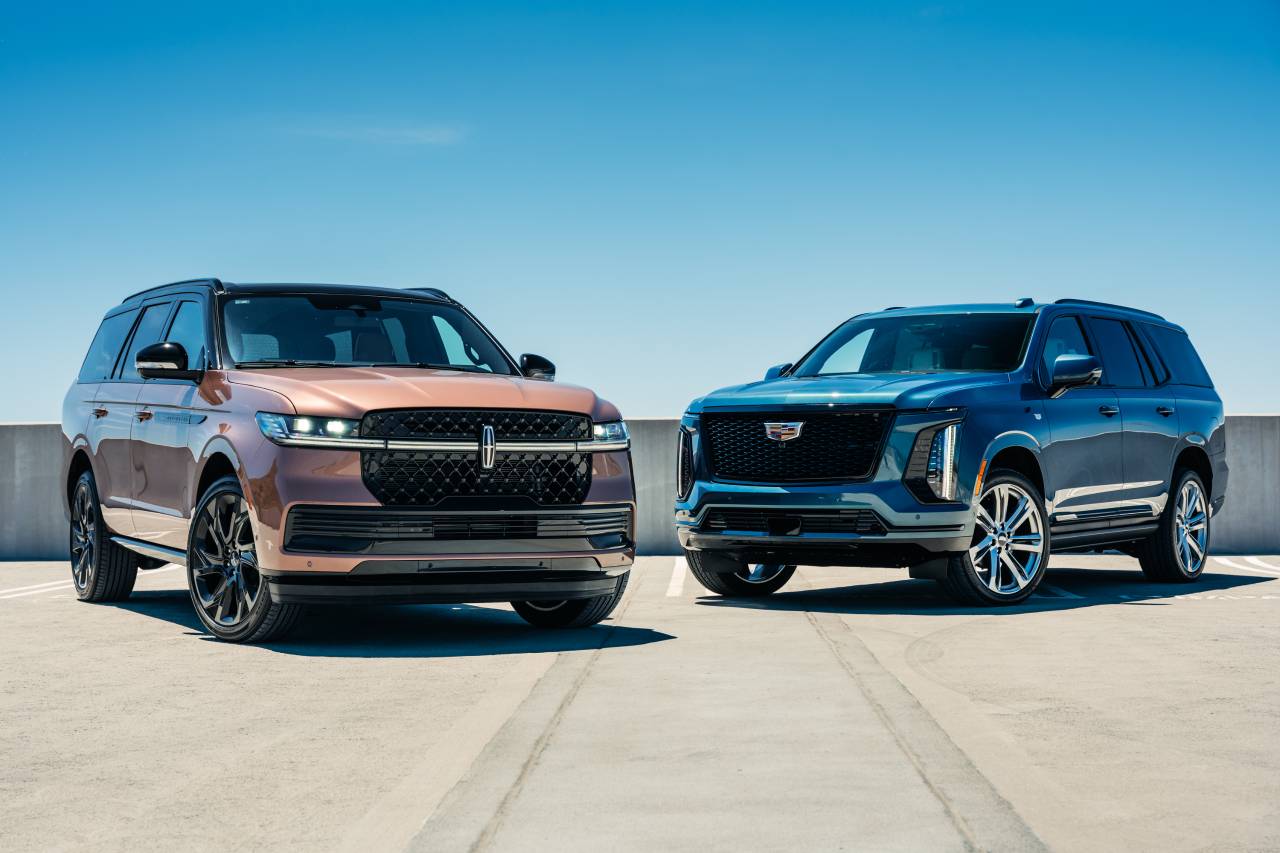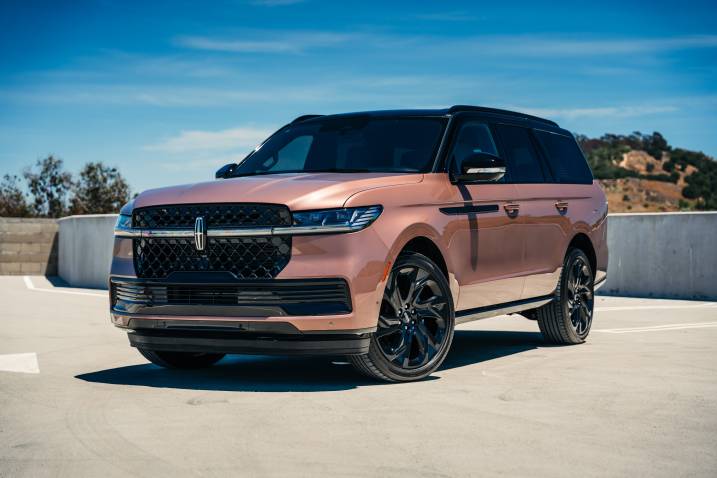Cadillac Optiq and Vistiq Both Aced the Edmunds EV Range Test
The two electric SUVs have almost identical real-world range
- The Optiq and Vistiq are Cadillac’s newest electric SUVs.
- The compact Optiq has 300 horsepower and seating for five, while the larger Vistiq boasts 615 hp and three rows of seats.
- Both SUVs exceeded their EPA estimates in the Edmunds EV Range Test.
Want an electric Cadillac SUV that isn’t an absolute behemoth? General Motors’ luxury arm has two new options for you to consider. The compact Optiq EV offers seating for five and sleek exterior styling, while the larger Vistiq gives you a bit more luxury and tech, plus a third row of seats.

Both boast an EPA-estimated driving range of around 300 miles. But our real-world range test shows it’s easy to beat those numbers — and not by a small amount.

Cadillac Optiq: 339 miles of range
We tested the Optiq in its Sport 2 trim, which uses an 85-kWh battery and two electric motors, giving this SUV all-wheel drive. Output is rated at 300 horsepower and 354 lb-ft of torque, and when we ran the Optiq through our instrumented testing procedure, we clocked a 0-to-60-mph sprint of 5.9 seconds. Not bad.
According to the EPA, this Optiq should see a driving range of 302 miles, but we recorded 339 miles on the Edmunds EV Range Test — a 12.2% improvement. What’s more, we observed better overall efficiency than what the EPA predicts, with our car using 29.8 kWh of energy per 100 miles, compared to the official estimate of 33 kWh per 100 miles.

Cadillac Vistiq: 334 miles of range
The Vistiq — sorry, the Vistiq 900 E4, which is such a stupid name — has a larger 102-kWh battery pack. Through its two electric motors, the Vistiq delivers an impressive 615 hp and 650 lb-ft of torque. That’s enough to get this 6,231-pound three-row SUV from 0 to 60 mph in a scant 3.9 seconds. Talk about quick.
What’s interesting is that, despite being larger and significantly more powerful than the Optiq, the Vistiq’s real-world driving range isn’t too far off. We saw 334 miles in the Edmunds EV Range Test — a 9.3% improvement over the EPA’s 305-mile estimate. Of course, the Vistiq is a lot less efficient than its smaller sibling, using 36.6 kWh per 100 miles.

How we range test
The Edmunds EV Range Test aims to show an EV’s most accurate real-world range based on the driving habits of most consumers. We use a route made up of 60% city and 40% highway driving, with an average speed of 40 mph. We stay within 5 mph of all posted speed limits and drive the vehicles in their most efficient settings, with the climate control set to auto and 72 degrees Fahrenheit.
Be sure to check out our full Edmunds EV Range Test leaderboard to see how the Optiq and Vistiq compare to other luxury SUVs. Also: Peep the Escalade IQ at the top of the list. It might be super-sized, but it’s got incredible range to back it up.
Photos by Keith Buglewicz
Share:
2025 Cadillac Escalade vs. 2025 Lincoln Navigator: Money Talks
We pick the better of the two biggest luxury SUVs you can buy

- The Cadillac Escalade is an American icon, and for 2025 it got some hefty updates.
- The Lincoln Navigator has long lived in its shadow, but can an all-new generation change that?
- We put these two American luxo barges head-to-head to find out which is best.
These two have been going at it for almost 30 years, but you probably didn’t realize that. The Cadillac Escalade was actually beaten to market in the late ’90s by the Lincoln Navigator, but the Lincoln’s reputation never blew up in quite the same way. For 2025, however, both get updates that make this a closer fight than ever.


What’s it like to drive a barge on the road?
The Escalade has reached American icon status since its debut in 1998. For 2025, it’s larger and more in charge than ever before. A refresh added more screen real estate, fiddled with the exterior design to bring it a touch more in line with the Cadillac brand’s contemporary aesthetic, and rejiggered the interior a bit.
But the 6.2-liter V8 under the hood that makes 420 horsepower and 460 lb-ft of torque remains completely unchanged, and despite the Caddy feeling more like a yacht than a Corvette, it remains the centerpiece of the driving experience. It burbles on startup and revs smoothly all the way to redline, with a nice American roar following you the entire way. It is by no means efficient — the EPA estimates just 16 mpg combined — but it is effective, easy to drive smoothly, and befitting of a big luxury truck.

Under the hood of the Lincoln, you’ll find another iteration of Ford’s turbocharged 3.5-liter V6 that makes 440 hp and 510 lb-ft of torque. Aside from being quicker to 60 mph than the Caddy, this motor is totally unremarkable. It’s powerful enough, the torque delivery is a flat, predictable line, and the transmission shifts without much fuss. But it doesn’t sound particularly luxurious, doesn’t rev as freely or as smoothly as the Escalade’s V8, and is just 1 mpg more efficient despite the downsizing and turbocharging.
But the Navigator’s on-road issues don’t stop there. The too-big 24-inch wheels feel like they actively fight the suspension as they roll over the road. The end result is something that floats around like a dinghy in a storm — the Navigator’s ride just never settles down.
To make matters worse, the steering in the Lincoln is diabolically slow, and the wheel is shaped like an oval. Around town and in parking lots, you are constantly moving the wheel about because of how reticent the front end is to respond to your inputs. It takes far too much getting used to and gets tiring (read: irritating) quickly.

The Escalade, by contrast, is a peach on the road. The ride is well controlled, if a bit firm, due to its also too-big 24-inch rollers. But the air springs and adaptive dampers do a much better job of controlling the body’s mass and isolating the cabin’s occupants from their resonance. Add in its normally shaped steering wheel and much more immediate response from the front end, and you get something that drives much smaller than it is and gives both comfort and confidence. Simply put, it is the better big ol’ bus to drive.
Interior delights … and disappointments
But as a thing to be driven in? The Navigator bathes you in swaths of leather and soft-touch materials, the front seats are adjustable 30 (you read that right) ways, and there is very little in the way of hard plastic. In fact, it’s hard to find much to complain about inside the Navigator. The material choice and construction are top-notch, and the design itself feels plush and modern.
Once you start digging into the screens a bit more, things get a little less impressive. There is an expanse of screen tucked up near where the windshield meets the dashboard that goes from pillar to pillar. It’s just there to display info — a touchscreen this is not. It’s well done, the resolution is high, and Lincoln made good use of the space. There are configurable widgets on the right side, and all the driver information you’ll need on the left (in addition to popups from things like the blind-spot camera and in-cabin warnings like the seat-belt chime).

But if you look down, there is a very clearly undersized display nestled within the dash. It’s too small and it controls most of the car’s functions — including the detailed adjustments for the seats and the direction of the air flow from the vents. The problem is it’s all too small, too difficult to use, and cramming so much of the car’s primary controls into a screen (and burying them in menu after menu) is maddening.
Once you get it all set up, it’s fine, but you’re going to need the patience of a saint.
The Escalade isn’t trouble-free when it comes to tech either. It has also gone for a massive pillar-to-pillar screen, but it just hasn’t made the best use of all that real estate. Most of the time, there are huge sections of nothing being displayed, and all you’re looking at is something akin to an iPhone background. Plus, the text is too small and, though it’s a touchscreen, it sits too far from the driver. Good thing there’s a scroll knob and some shortcut buttons in the center console to make navigating it a simpler affair.
And then there’s the rest of the cabin. The interior just doesn’t fit the bill of a near $130,000 luxury barge, and it starts with that scroll knob. It looks nice, but it’s a bit cheap-feeling to manipulate and use and that’s emblematic of the rest of the interior. The leathers are nice enough, even the front chairs aren’t as comfortable or plush as what’s in the Lincoln. There is a lot more hard plastic and piano black littered throughout the cabin, and even something Cadillac did well, namely the wood detailing on the dashboard, is covered by a lacquer that makes it look more like plastic.

The back seats are nowhere near as plush in the Caddy either. In fact, it feels like Cadillac ripped them straight from a Chevy Astro van, layered them up in a leather that vaguely resembles what’s on the front seats, and called it done. The rear seats in the Navigator are more plush, more adjustable, and, because the Lincoln had the luxe rear seat package, came with heating, ventilation and massaging. You can get an executive rear-seat package in the Cadillac, but the car we tested didn’t come with it.
But even if the Cadillac did come with that rear-seat package, the chances it wins on interior comfort, material choice, quality, and even design are slim. It’s just not as nice everywhere you look, and unless you want oodles of space, the Lincoln does a better job of being a luxury machine — even its third row is heated. If space is your biggest concern, get a Suburban and or Expedition. This is a luxury comparison, and the Navigator wins out here big time.
Picking a winner
Thankfully, both do some things really well. Space won’t be an issue in either because they’re both massive, and both come with some of the most impressive driver assistance tech on sale right now. Ford’s BlueCruise and GM’s Super Cruise are both highly impressive hands-free, eyes-on Level 2+ autonomous systems — they’re neck and neck for the lead, so we can’t separate the two here.

Both of the big SUVs we tested here cost over $120,000, and bang for your buck isn’t exactly at an all-time high with either. Both cost over $90,000 to start, both get abysmal fuel economy (17 mpg combined for the Lincoln to the Escalade’s 16 mpg combined), and both have places where they don’t feel like they’re worth as much as they cost.
That said, the Lincoln excels in more places than the Cadillac does, and so it gets the nod. Despite its on-road quirks, the Navigator is a more sumptuous place to be, the tech is better executed, and there are more thoughtful luxury touches dotted around the interior. For now, the Lincoln has snatched the Caddy’s crown, both in our heads and via the objective measure of our ratings system — the Navigator scored a 7.7; the Escalade loses out, just barely, at 7.6.
With all that said, we don’t think this battle will be over anytime soon.




